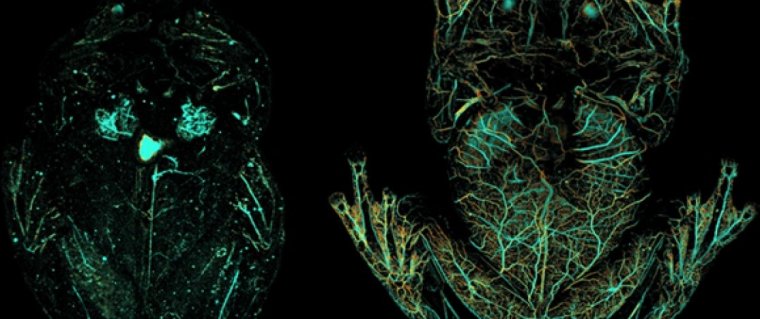| News / Science News |
Glassfrogs hide red blood cells in their livers to become transparent
Glassfrogs make themselves transparent while they rest by taking red blood cells from circulation and concealing them in their livers.

Photoacoustic microscopy images showing red blood cells in a glassfrog while asleep and under anesthesia. Photo: Junjie Yao/Duke University
Now, a team of biologists and biomedical engineers has shown how these frogs become see-through in a new research.
It's easy to miss a glassfrog in its natural environment. The northern glassfrog, Hyalinobatrachium fleischmanni, measures no more than a few centimeters and is most active at night, when its green skin helps it blend in with surrounding leaves and foliage.
But these amphibians become true masters of camouflage during the day when they're asleep.
"When glassfrogs are resting, their muscles and skin become transparent, and their bones, eyes and internal organs are all that's visible," said Carlos Taboada, co-first author of the paper.
"These frogs sleep on the bottoms of large leaves, and when they're transparent, they can perfectly match the colors of the vegetation."
Many animals in the sea can change the color of their skin or become completely transparent, but it's far less common on land. One reason transparency is so difficult to achieve is because of red blood cells in the circulatory system.
Red blood cells are adept at absorbing green light, which is the color of light usually reflected by plants and other vegetation.
In return, these oxygen-rich cells reflect red light, making blood –– and by extension the circulatory system –– highly visible, especially against a bright green leaf.
Glassfrogs are some of the only land-based vertebrates that can achieve transparency, which has made them a target for study.
Taboada first began studying glassfrogs with Sönke Johnsen, a biologist at Duke University who specializes in studying transparency. Working with Jesse Delia, who traveled around the world collecting different glassfrogs for the study, the scientists observed that red blood cells seemed to be disappearing from the circulating blood whenever the frogs became transparent.
They conducted additional imaging tests on the animals, proving via optical models that the animals were able to achieve transparency because they were pushing red blood cells out of their vessels.
"If these frogs are awake, stressed or under anesthesia their circulatory system is full of red blood cells and they are opaque," explained Delia, a researcher at the American Museum of Natural History. "The only way to study transparency is if these animals are happily asleep, which is difficult to achieve in a research lab."
In the lab imaging setup, the frogs slept upside down in a petri dish, similar to how they sleep on leaves, and the team shined green lasers on the animals.
The red blood cells in the frogs' bodies absorbed the green light and emitted ultrasonic waves, which were then picked up by an acoustic sensor to trace their whereabouts.
The results were clear: When the frogs were asleep, they removed nearly 90% of their circulating red blood cells and stored them in their livers. (U.S. National Science Foundation)
YOU MAY ALSO LIKE





